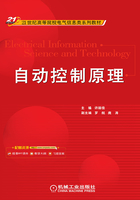
2.3 控制系统的复数域数学模型
控制系统的微分方程是在时间域描述系统动态性能的数学模型,在给定外作用及初始条件下,求解微分方程可以得到系统的输出响应。这种方法比较直观,特别是借助于计算机可以迅速而准确地求得结果。但是若系统的结构改变或某个参数变化时,就要重新列写并求解微分方程,这样不便于对系统进行分析和设计。
用拉普拉斯变换法求解线性系统的微分方程时,可以得到控制系统在复数域中的数学模型即传递函数。传递函数不仅可以表征系统的动态性能,而且可以用来研究系统的结构或参数变化对系统性能的影响。经典控制理论中广泛应用的频率法和根轨迹法,就是以传递函数为基础建立起来的,传递函数是经典控制理论中最基本和最重要的概念。利用传递函数不必求解微分方程,即可研究初始条件为零的系统在输入信号作用下的动态过程。
2.3.1 传递函数的定义和性质
1. 传递函数的定义
线性定常系统的传递函数是指在零初始条件下,系统的输出量与输入量的拉普拉斯变换之比。零初始条件是指当t≤0时,系统的输入量u(t)、输出量c(t)以及它们的各阶导数均为零。
设线性定常系统由下述n阶线性常微分方程描述:

式中,ai(i=1,2,…,n)和bj(j=1,2,…,m)为常系数,由系统的结构和参数决定。有C(s)=L[c(t)],U(s)=L[u(t)],在零初始条件下,系统关于s的代数方程整理为

于是,系统的传递函数为

下面举例说明如何求取简单环节的传递函数。
【例2-16】 已知图2-1所示RLC电路网络的微分方程为

求该RLC电路网络的传递函数。
解:当初始条件为零时,RLC电路网络微分方程的拉普拉斯变换为
(LCs2+RCs+1)Uc(s)=Ur(s)
则该电路网络的传递函数为

【例2-17】 求图2-7所示电路网络的传递函数 。
。

图2-7 某电路网络
解:根据运算放大器“虚地”“虚断”“虚短”的概念,结合基尔霍夫定律,该电路网络的传递函数计算如下:

2. 传递函数的性质
传递函数的性质如下:
1)传递函数经拉普拉斯变换推导出来,而拉普拉斯变换是一种线性积分运算,所以传递函数只适用于线性定常系统。
2)传递函数是复变量s的有理真分式,其分子多项式和分母多项式的各项系数均为实数,且分子多项式的阶次m低于或等于分母多项式的阶次n。
3)传递函数只取决于系统或元件的结构和参数,与输入量的大小和形式无关,也无法反映系统内部的任何信息。
4)传递函数中各项系数值和微分方程中各项系数对应相等。当确定了系统时域内的数学模型——微分方程,则系统在复域内的传递函数可唯一确定。
5)传递函数G(s)的拉普拉斯反变换是系统的脉冲响应k(t)。
k(t)是系统在单位脉冲δ(t)输入时的输出响应。此时U(s)=L[δ(t)]=1,故有
k(t)=L-1[C(s)]=L-1[C(s)U(s)]=L-1[G(s)]
对于简单的系统和元件,首先列出它的输出量与输入量的微分方程,求其在零初始条件下的拉普拉斯变换,然后由输出量与输入量的拉普拉斯变换之比,即可求得系统的传递函数。对于较复杂的系统和元件,可以将其分解成各局部环节,求得环节的传递函数,然后利用本章所介绍的框图变换法则,计算系统总的传递函数。
2.3.2 典型环节的传递函数
一个实际的控制系统是由各种元部件组成的,如放大元件、执行机构和测量装置等。虽然各种元件的物理性质和结构用途方面都有着很大的差异,但若抛开其具体结构和物理特点,研究其运动规律和数学模型的共性,就可以划分成为数不多的几种典型环节。这些典型环节是比例环节、积分环节、微分环节、比例微分环节、惯性环节、二阶振荡所节和滞后环节。由于典型环节是按数学模型的共性划分,不同物理结构的元件可以在形式上具有完全相同的传递函数。
1. 比例环节
比例环节是一个最基本的环节,又称为放大环节,其输出量以一定比例复现输入信号。比例环节的微分方程为

式中,K为常数,称为放大系数或增益。图2-8为比例环节的框图。

图2-8 比例环节
比例环节的传递函数为

如齿轮减速器、无弹性变形的杠杆、不计非线性和惯性的电子放大器、测速发电机(输出为电压、输入为转速)等都可以认为是比例环节。但应指出,完全理想的比例环节在实际中是不存在的。杠杆总存在弹性变形,电子放大器的放大系数也会随输入信号的频率改变而发生变化,测速发电机电压与转速之间的关系也不完全是线性关系。因此把上述这些环节当作比例环节是一种理想化的方法。但要注意理想化的条件和适用范围。
2. 积分环节
积分环节又称为无差环节。积分环节的微分方程为

式(2-38)表明,积分环节的输出量与输入量的积分成正比。其传递函数为


图2-9 运算放大器
图2-9所示的由运算放大器组成的积分器,其输入电压ur(t)和输出电压uc(t)之间的关系为

对式(2-40)两边取拉普拉斯变换,求得传递函数为

在实际工程中,水槽液位、烤箱温度和电动机转速等系统都属于积分环节。
3. 微分环节
微分环节又称为超前环节,是控制系统中常用环节。
1)理想微分环节。理想微分环节仅在理论上存在,在实际工程中不能单独实现。其特点是在暂态过程中,输出量为输入量的微分,即

式中,K为时间常数。对应的传递函数为

图2-10c所示的测速发电机,当其输入量为转角φ,输出量为电枢电压Uc时,具有微分环节的作用。设测速发电机的角速度为ω= ,其输出电压uc与其角速度ω成正比,则有
,其输出电压uc与其角速度ω成正比,则有

故传递函数为

2)实际微分环节。实际微分环节又称为复合微分环节,图2-10a所示的RC电路,是实际中常用的微分环节,其微分方程为

消去中间变量,可得

其传递函数为

式中,T=RC为时间常数。
当RC≤1时,则其传递函数近似写成

3)比例微分环节。图2-10b所示的RC电路也是微分环节,它与图2-10a所示的微分电路不同之处在于,电压ur为输入量,回路电流i为输出量。根据电路原理可知,当输入电压ur发生变化时,有


图2-10 微分环节
故该电路的传递函数为

式中,T=RC为微分时间常数。具有这种传递函数形式的环节即为比例微分环节。
4)惯性环节。惯性环节因含有储能元件,所以对突变的输入信号不能立即复现。其特点是输出量缓慢地反映输入量的变化。惯性环节的微分方程为

其传递函数为

式中,K为比例系数;T为惯性环节的时间常数。从式(2-53)可知,当T=0时,该环节即为比例环节。
图2-11所示的RC电路即是惯性环节,其输入电压ur(t)和输出电压uc(t)之间的关系为


图2-11 RC电路
对式(2-54)取拉普拉斯变换,求得传递函数为

在实际工程中,如单容液位系统、电热炉炉温系统等,均可视为惯性环节。
5)二阶振荡环节。二阶振荡环节的微分方程为

其传递函数为

式中,T为时间常数;K为放大系数;ζ为阻尼系数(也称阻尼比);ωn为无阻尼自然振荡频率。对于振荡环节,0≤ζ<1。
有两个储能元件的系统属于二阶系统,图2-1所示的RLC电路、图2-3所示的弹簧-质量-阻尼系统均属于二阶振荡环节。
6)滞后环节。滞后环节也称为延迟环节,其输出信号与输入信号的形状完全相同,只是在延迟一段时间后复现原函数。其数学表达式为

式中,τ为滞后时间。
由拉普拉斯变换的平移定理,可求得其输出量在零初始条件下的拉普拉斯变换为

其传递函数为

在实际工程中,如晶闸管整流装置、流体管道传输和热交换系统等,均属于滞后环节。
【例2-18】 图2-12所示为简化后的直流发电机电路。其中,转子为恒速转动,其输入为励磁电压ui,输出为电压uo,求此系统的传递函数。

图2-12 直流发电机电路
解:励磁电路电压方程为

在输出电路中转子为恒速,有
u o(t)=K1i(t)

对上式取拉普拉斯变换,则系统传递函数为
